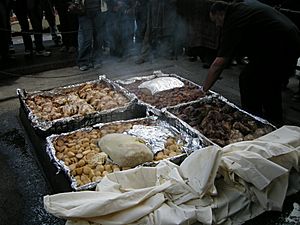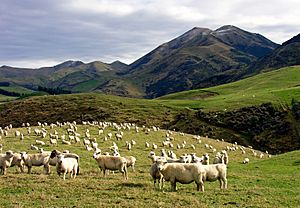Māori cuisine facts for kids
When the Māori first arrived in New Zealand from tropical Polynesia, they brought many food plants with them. These included kūmara (sweet potato), taro, uwhi, hue and tī-pore. Most of these plants grew best in the north of the North Island. Kūmara, however, could grow further south, even into the northern South Island. It became a very important food that could be stored for winter.

Native New Zealand plants also became a big part of their diet. For example, fernroot was eaten. They also ate insects like the huhu grub. Even earthworms, called noke, were sometimes part of traditional Māori meals. While growing some crops was tricky, New Zealand had lots of birds and sea creatures. Sadly, the large flightless moa birds were hunted until they disappeared. To protect food sources, Māori used Rāhui. This meant stopping hunting certain animals or fishing in specific places or at certain times. This helped the animal populations grow back.
Traditional Māori Cooking Methods
Like other Polynesian people, Māori cooked food in earth ovens. These ovens are known as hāngi in New Zealand. The word umu is also used, just like in other Pacific languages. To make a hāngi, stones are heated by fire. Food, wrapped in leaves, is then placed on top of the hot stones. More leaves, cloth, or wet sacks cover the food. Finally, earth is piled on top to trap the heat.
Other ways of cooking included roasting food over a fire. In areas with geothermal activity, Māori used natural hot springs and pools. They would boil or steam food using the earth's natural heat. Sometimes, in non-geothermal areas, hot stones were put into a bowl of water with food to boil it. Some foods were also cooked directly over an open fire. Māori also preserved food. They used smoke, air-drying, or layers of fat. This was especially true for muttonbirds.
Food and Māori Beliefs
In traditional Māori religion, food was considered noa. This means it was non-sacred or ordinary. Because of this, people had to be careful. They made sure food did not touch tapu (sacred) places or objects. If food touched something tapu, the sacredness of that place or object could be harmed. Often, the people connected to it could also be affected.
Important chiefs and people doing sacred work, like tattooing, were tapu themselves. This meant they had rules about how they could handle food. The most tapu people sometimes even needed others to feed them. This shows how important it was to keep noa and tapu separate.
European Foods and Their Impact
When Europeans, called Pākehā, first arrived in New Zealand, they brought their own foods. This started in the late 1700s. Some of these new foods quickly became popular with Māori. Pork and potatoes were two examples. Potatoes were especially liked. They were grown in a similar way to kūmara. But potatoes gave a much larger harvest with less effort.
Other European foods also became part of the Māori diet. These included wheat, pumpkin, mutton, sugar, and many types of fruit. Māori traded these new foods widely with visiting ships. American sailors even brought new kinds of kūmara to New Zealand. These new types produced more food and quickly replaced the original varieties. Today, most kūmara are commercial types like Owairaka Red, Toka Toka Gold, and Beauregard.
Many Māori tribes grew extra food. They traded this food with other tribes and with European visitors and settlers. Some tribes became wealthy from this trade. However, the Māori food industry started to decline in the mid-1800s. This was due to land loss and competition from European farmers. Also, many traditional food sources became scarce. For example, the kereru (wood pigeon) and other birds, along with some fish and plants, became harder to find. This happened as forests were cut down and some species were hunted too much.



